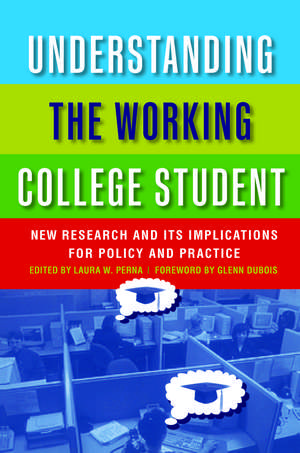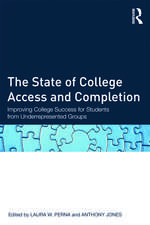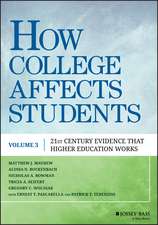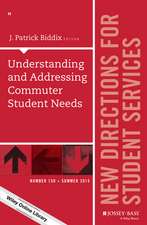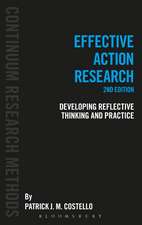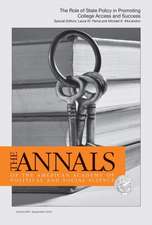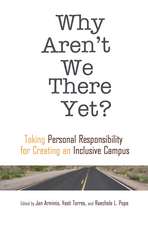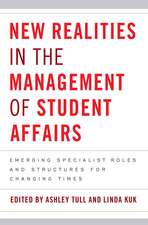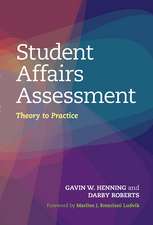Understanding the Working College Student: New Research and Its Implications for Policy and Practice
Editat de Laura W. Pernaen Limba Engleză Paperback – 2 mar 2010
Preț: 285.66 lei
Nou
Puncte Express: 428
Preț estimativ în valută:
54.67€ • 56.86$ • 45.13£
54.67€ • 56.86$ • 45.13£
Carte disponibilă
Livrare economică 24 martie-07 aprilie
Preluare comenzi: 021 569.72.76
Specificații
ISBN-13: 9781579224271
ISBN-10: 157922427X
Pagini: 328
Dimensiuni: 152 x 229 x 21 mm
Greutate: 0.48 kg
Ediția:1
Editura: Taylor & Francis
Colecția Routledge
Locul publicării:Oxford, United Kingdom
ISBN-10: 157922427X
Pagini: 328
Dimensiuni: 152 x 229 x 21 mm
Greutate: 0.48 kg
Ediția:1
Editura: Taylor & Francis
Colecția Routledge
Locul publicării:Oxford, United Kingdom
Public țintă
PostgraduateCuprins
Foreword—Glenn DuBois Introduction—Laura W. Perna SECTION I. WORK AS A FORM OF FINANCIAL AID 1. Undergraduate Work and the Student Aid System—Sandy Baum SECTION II. WORK AS A COMPONENT OF STUDENT IDENTITY 2. Adult Workers as Undergraduate Students. Significant Challenges for Higher Education Policy and Practice—Carol Kasworm 3. Overcoming Adversity. Community College Students and Work—John S. Levin, Virginia Montero Hernandez & Christine Cerven 4. Mobile Working Students. A Delicate Balance of College, Family, and Work—Mary Ziskin, Vasti Torres, Don Hossler, & Jacob P.K. Gross 5. Academic Success for Working Adult Students—Heather T. Rowan-Kenyon, Amy K. Swan, Nancy L. Deutsch, & Bruce Gansneder SECTION III. WORK AS A VEHICLE FOR PROMOTING COGNITIVE DEVELOPMENT AND LEARNING 6. Using Economics to Illuminate the Dynamic Higher Education Landscape—Doug Lynch, Michael Gottfried, Wendy Green & Chris Allen Thomas
Notă biografică
Laura W. Perna is an associate professor of higher education the Graduate School of Education at the University of Pennsylvania. Her current scholarship focuses on understanding the ways that public and institutional policies enable and restrict college access and success especially for students from underrepresented minority groups and from low socioeconomic backgrounds. Glenn DuBois
Recenzii
“Laura Perna has pulled together an exceptional group of scholars to address a new challenge: how college students are responding to the necessity to work excessively to pay for college, and the ways their faculty and institutions are responding to these new conditions. This outstanding book documents transformations in college experiences for a growing number of students who now must work long hours, in addition to excessive borrowing, to achieve academic success in college.”
Edward P. St. John, Algo D. Henderson College Professor of Higher Education
University of Michigan
“Laura Perna and the contributing authors have produced a work that will be extremely helpful in assisting colleges and universities address the needs of our working students. The reality is that our students are more diverse from many aspects and we can no longer selectively address the diverse issues that our students face as they seek degree completion. This volume is critical for administrators and board members as we assess our effectiveness at meeting the needs of working students and our expectations for timely degree completion. We must listen to the authors and adjust our institutions to meet students’ needs.”
Kevin D. Rome, Vice Chancellor for Student Affairs and Enrollment Management
North Carolina Central University
“Is our education system keeping up? Can its traditions meet today’s demands? Is life-long learning now a requirement for everybody and if so, what does that mean for our community colleges and universities? These questions should drive the agendas and conversations of every board and every educational policy maker in our county. I applaud Laura Perna for giving us a good place to begin that discussion with Understanding the Working College Student.”
Glenn DuBois, Chancellor, Virginia Community College System
from the Foreword
“Why do a majority of undergraduate students work and what are the costs, opportunities, outcomes, and policy implications? The authors insightfully use qualitative and quantitative research methodologies and social justice, identity, labor, economic, learning, and other theories to explore these issues. This volume enlightens us about better understanding, serving, and engaging these students in and out of the classroom. Community college and university leaders and public policymakers can glean how to reconceptualize student employment and financial aid, be transformative rather than replicative, and thus enhance the 'life chances' of our diverse 'mobile working students'".
Magdalena H. de la Teja, Vice President for Student Development Services, Tarrant County College, Northeast Campus
"For too long, policy makers, administrators, scholars, faculty, student personnel staff, and even students have discounted the role and value of work in undergraduate students’ lives. Dr. Perna and her collaborators put work up front in this serious and comprehensive examination of working students. By drawing on up-to-date research, the authors help us understand why students work and the consequences relative to student identity, cognitive development, engagement, and educational outcomes. The working student experience—particularly the adult student—is complex and this book provides a thorough resource for learning from rich student vignettes to economic modeling. With employment the norm for undergraduates, it provides the context to go beyond tacit acknowledgement and mere tolerance for employed students to policies and practices that carry social, economic, political, and institutional implications.”
Lorilee R. Sandmann, Professor, Adult Education, Department of Lifelong Education, Administration & Policy, University of Georgia
“Working while enrolled in higher education has become the norm. Understanding the working college student provides the guidance educators and policy makers need to make work a resource for, rather than an obstacle to academic success. Educators and policy makers alike need to read and act on what they learn from this book.”
Paul E. Lingenfelter, President, State Higher Education Executive Officers
“While our postsecondary educational system confronts many challenges in serving today’s ‘working students’, this volume is the first work that really examines the issues and offers suggestions on how we should proceed. The book is well organized, easy to follow, and extremely well written. The research contained within the chapters is up to date, straight forward, and filled with valuable information. Educational policy makers, college administrators, faculty, and others who want to become knowledgeable about today’s working students should definitely read the analysis and findings presented in this book."
A. Dallas Martin Jr., President Emeritus, National Association of Student Financial Aid Administrators
"With this in-depth, comprehensive collection of recent research, editor Laura W. Perna draws much-needed attention to the needs of the growing share of students who work. Using contributions from leading scholars, the volume details the vast diversity in students' experiences surrounding work and school. The colelction emphasizes the significant contributions that policymakers and educators could make by creating academic cultures, education initiatives, and financial practices that acknowledge the reality of work in students' lives. It also underscores the importance of using work as a lever for increasing student engagement. The book is an important resource for anyone considering how economics can and could affect student success."
Diversity and Democracy
"The collective authors of Understanding the Working College Student address the topic by reviewing research and sharing insights that enrich our understanding of the realities of working students - both traditional-age and adult - including why students work and the consequences relative to student identity, learning, student engagement, and educational outcomes. The volume explores the difficulty of funding a college education and the challenges of trying to meet the multiple and sometimes conflicting demands of the roles of student, employee, and family, and the resulting high levels of stress and barriers to degree completion. Higher education scholars, policy makers, and campus administrators and student affairs educators are presented with a comprehensive review of a wealth of research regarding the experiences of students who work. Each chapter offers a sensible balance between solid research findings and implications for practice.... Understanding the Working College Student is a comprehensive resource that should interest a variety of readers across a wide range of institutional contexts and settings. The volume is particularly useful for scholars and practitioners who aim to more fully understand the complexities of the working student experience and carve out future topics for research and create responsive practice."
Journal of College Student Development
"This book is a crucial text for college administrators, policy makers, and faculty, as the working student population is growing exponentially. Seminaries, divinity schools, as well as publicly and privately funded colleges and universities will need to address the demands of this expanding population."
Teaching Theology and Religion
"While it may seem obvious that many college students work because they need to, research on the implications of that for them and the institutions they attend was skimpy and scattered, the authors found. Their book pulls together research and data from a variety of sources to provide a more comprehensive picture of the working student. In contrast to the image of the “traditional” full-time student who does not work or works a few hours at most, the authors note that the working student is the norm today.
Almost half of all full-time undergraduates and 81 percent of part-time undergraduates worked, according to a 2008 report from the U.S. Department of Education. Better understanding of such students could lead to changes in policies and practices and help increase the number of Americans who earn college degrees, the authors argue. Their book looks at how work affects students’ grades, their identities, eligibility for student aid, engagement in the college experience, participation in extracurricular activities, likelihood of graduating and even their future salaries. Not surprisingly, the researchers found that work takes its toll, but they conclude that it may offer benefits as well. For example, students who work a limited number of hours may have higher grades, and those who work during college may reap higher incomes later."
Diverse Issues in Higher Education
Edward P. St. John, Algo D. Henderson College Professor of Higher Education
University of Michigan
“Laura Perna and the contributing authors have produced a work that will be extremely helpful in assisting colleges and universities address the needs of our working students. The reality is that our students are more diverse from many aspects and we can no longer selectively address the diverse issues that our students face as they seek degree completion. This volume is critical for administrators and board members as we assess our effectiveness at meeting the needs of working students and our expectations for timely degree completion. We must listen to the authors and adjust our institutions to meet students’ needs.”
Kevin D. Rome, Vice Chancellor for Student Affairs and Enrollment Management
North Carolina Central University
“Is our education system keeping up? Can its traditions meet today’s demands? Is life-long learning now a requirement for everybody and if so, what does that mean for our community colleges and universities? These questions should drive the agendas and conversations of every board and every educational policy maker in our county. I applaud Laura Perna for giving us a good place to begin that discussion with Understanding the Working College Student.”
Glenn DuBois, Chancellor, Virginia Community College System
from the Foreword
“Why do a majority of undergraduate students work and what are the costs, opportunities, outcomes, and policy implications? The authors insightfully use qualitative and quantitative research methodologies and social justice, identity, labor, economic, learning, and other theories to explore these issues. This volume enlightens us about better understanding, serving, and engaging these students in and out of the classroom. Community college and university leaders and public policymakers can glean how to reconceptualize student employment and financial aid, be transformative rather than replicative, and thus enhance the 'life chances' of our diverse 'mobile working students'".
Magdalena H. de la Teja, Vice President for Student Development Services, Tarrant County College, Northeast Campus
"For too long, policy makers, administrators, scholars, faculty, student personnel staff, and even students have discounted the role and value of work in undergraduate students’ lives. Dr. Perna and her collaborators put work up front in this serious and comprehensive examination of working students. By drawing on up-to-date research, the authors help us understand why students work and the consequences relative to student identity, cognitive development, engagement, and educational outcomes. The working student experience—particularly the adult student—is complex and this book provides a thorough resource for learning from rich student vignettes to economic modeling. With employment the norm for undergraduates, it provides the context to go beyond tacit acknowledgement and mere tolerance for employed students to policies and practices that carry social, economic, political, and institutional implications.”
Lorilee R. Sandmann, Professor, Adult Education, Department of Lifelong Education, Administration & Policy, University of Georgia
“Working while enrolled in higher education has become the norm. Understanding the working college student provides the guidance educators and policy makers need to make work a resource for, rather than an obstacle to academic success. Educators and policy makers alike need to read and act on what they learn from this book.”
Paul E. Lingenfelter, President, State Higher Education Executive Officers
“While our postsecondary educational system confronts many challenges in serving today’s ‘working students’, this volume is the first work that really examines the issues and offers suggestions on how we should proceed. The book is well organized, easy to follow, and extremely well written. The research contained within the chapters is up to date, straight forward, and filled with valuable information. Educational policy makers, college administrators, faculty, and others who want to become knowledgeable about today’s working students should definitely read the analysis and findings presented in this book."
A. Dallas Martin Jr., President Emeritus, National Association of Student Financial Aid Administrators
"With this in-depth, comprehensive collection of recent research, editor Laura W. Perna draws much-needed attention to the needs of the growing share of students who work. Using contributions from leading scholars, the volume details the vast diversity in students' experiences surrounding work and school. The colelction emphasizes the significant contributions that policymakers and educators could make by creating academic cultures, education initiatives, and financial practices that acknowledge the reality of work in students' lives. It also underscores the importance of using work as a lever for increasing student engagement. The book is an important resource for anyone considering how economics can and could affect student success."
Diversity and Democracy
"The collective authors of Understanding the Working College Student address the topic by reviewing research and sharing insights that enrich our understanding of the realities of working students - both traditional-age and adult - including why students work and the consequences relative to student identity, learning, student engagement, and educational outcomes. The volume explores the difficulty of funding a college education and the challenges of trying to meet the multiple and sometimes conflicting demands of the roles of student, employee, and family, and the resulting high levels of stress and barriers to degree completion. Higher education scholars, policy makers, and campus administrators and student affairs educators are presented with a comprehensive review of a wealth of research regarding the experiences of students who work. Each chapter offers a sensible balance between solid research findings and implications for practice.... Understanding the Working College Student is a comprehensive resource that should interest a variety of readers across a wide range of institutional contexts and settings. The volume is particularly useful for scholars and practitioners who aim to more fully understand the complexities of the working student experience and carve out future topics for research and create responsive practice."
Journal of College Student Development
"This book is a crucial text for college administrators, policy makers, and faculty, as the working student population is growing exponentially. Seminaries, divinity schools, as well as publicly and privately funded colleges and universities will need to address the demands of this expanding population."
Teaching Theology and Religion
"While it may seem obvious that many college students work because they need to, research on the implications of that for them and the institutions they attend was skimpy and scattered, the authors found. Their book pulls together research and data from a variety of sources to provide a more comprehensive picture of the working student. In contrast to the image of the “traditional” full-time student who does not work or works a few hours at most, the authors note that the working student is the norm today.
Almost half of all full-time undergraduates and 81 percent of part-time undergraduates worked, according to a 2008 report from the U.S. Department of Education. Better understanding of such students could lead to changes in policies and practices and help increase the number of Americans who earn college degrees, the authors argue. Their book looks at how work affects students’ grades, their identities, eligibility for student aid, engagement in the college experience, participation in extracurricular activities, likelihood of graduating and even their future salaries. Not surprisingly, the researchers found that work takes its toll, but they conclude that it may offer benefits as well. For example, students who work a limited number of hours may have higher grades, and those who work during college may reap higher incomes later."
Diverse Issues in Higher Education
Descriere
This book offers the most complete and comprehensive conceptualization of the “working college student” available. It provides a multi-faceted picture of the characteristics, experiences, and challenges of working college students and a more complete understanding of the heterogeneity underlying the label “undergraduates who work”.
